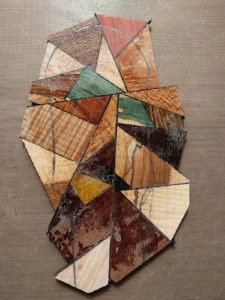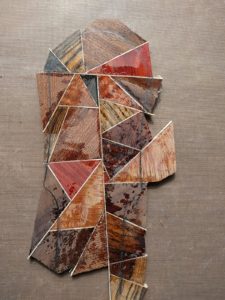I have had an interest in the fungi, wild mushrooms, etc. for many years.
I have been working on making the roughs for “Picasso” headplates. These allow me to use all of those little pieces of really nice wood I could not bear to throw out. These constructions also allow me to use more unusual things. In this construction, notice the blue-green elements. This is tulip poplar stained blue-green by the fungus Chlorociboria aeruginascens (or Chlorociboria aeruginosum, the two species can only be told apart microscopically). I have found this staining before, but usually on small bits of wood on the forest floor. One rarely sees the actual fruiting bodies, which are small cups the same blue-green color.
When splitting up some old poplar which had been sitting outside recently I found a piece that had a rather large area of blue-green stain. So I saved it, cut it into plates, soaked it with thin CA glue to harden it, and now can use it for a bit of unusual color. This is not a new use by the way. The use of this blue-green stained wood for decorative marquetry and intarsia goes back to the 15’th century. It is used today in decorative woodworking such as Tunbridge ware. The blue-green color is very stable over time.
Here is another headplate, this one made with white veneer inter-panel strips, and primarily darker woods.

